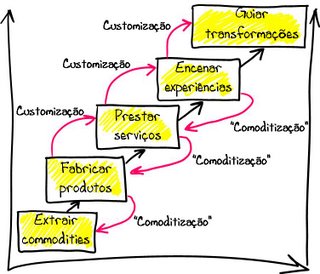Diz-se que o saber está nas universidades, que as empresas têm de cooperar mais com as universidades para ganharem o futuro num mundo onde o conhecimento faz milagres... Oh, wait!!!
.
E este discurso "
Ensino superior privado não consegue estancar perda de estudantes"... nem uma palavra sobre o valor... tudo sobre as propinas (o preço) e a incapacidade de reduzir custos. Nem uma palavra sobre estratégia, e como entender este pensamento:
"Ainda assim, João Redondo não duvida que exista uma explicação conjuntural para a quebra da procura dos últimos dois anos."
Impressionante!!!
Conjuntural?!?!?!
E a demografia?
E a oferta das universidades estatais?
.
.
Há anos que penso e escrevo por aqui que as universidades privadas deviam olhar para as estatais como uma empresa portuguesa olha para a concorrência chinesa e ter em conta a lição:
"Don't try to compete with China on costs and with Wal-Mart Amazon on price"
Por que é que muitas famílias, no passado, faziam um sacrifício e colocavam os seus filhos nas universidades privadas? Por que não tinham lugar nas estatais!
O que é que aconteceu entretanto? Mais lugares nas universidades estatais e menos, muito menos alunos a chegarem ao ensino superior, por causa da demografia.
.
Ponham-se no lugar de uma família, qual é o JTBD (job to be done)?
- Dar uma ferramenta para os meus filhos terem mais oportunidades na sua vida futura;
Acham que uma família não é capaz de fazer sacrifícios pelos seus filhos, na esperança de lhes dar o melhor?
Qual o discurso que lemos?
""Há menos dinheiro e as famílias começam a fazer contas a todos estes custos", avalia o presidente da APESP. "Primeiro têm de confortar o estômago e as casas.""
Custos, custos, custos... este discurso sem paixão, sem sonho e resignado, não cativa clientes. Cria nos potenciais clientes a ideia de que não há diferença entre o ensino das universidades estatais e das universidades privadas... se não há diferença, qual é a que tem o preço mais baixo?
.
Julgo que as universidades privadas precisavam de cooperar mais com as PMEs exportadoras para aprenderem o truque de David e actuarem no mercado com sucesso, apesar dos chineses.
.
Recordando o velho esquema de Pine & Gilmore:
Uma universidade não dá nada de palpável a um aluno a não ser um canudo no final. Uma universidade pode prestar-lhe um serviço que o leva a viver experiências que o transformam!
.
As universidades privadas (e as públicas) deviam fugir do discurso dos custos e do preço e concentrarem-se no discurso do valor, da experiência de ensino que proporcionam e na transformação que co-criam nos seus alunos.
.
Quando a demografia ajudava, já o escrevi aqui, a estratégia era existir, era ter as portas abertas que os clientes faziam fila para comprar. Agora não basta existir, é preciso seduzir!
.
Seduzir não é enganar, seduzir é ensinar a sonhar, é ensinar a voar mais alto...
.
Desde os meus 7/8 anos que uma das minhas leituras foi a Mitologia Grega e pensando em Ícaro, parece que estas universidades vão morrer não porque pensaram em grande e aproximaram-se demasiado do Sol, mas porque pensam pequenino, não sonham, não saem do mundo dos custos e, por isso, a humidade do mar vai precipitá-las no oceano.
BTW, o meu parceiro de almoço de ontem falou sobre este discurso
"As universidades e politécnicos privados cobram entre 2500 e 4000 euros anuais pelas licenciaturas - com excepções pontuais de cursos nas áreas da saúde -, um valor que fica abaixo do que é cobrado em Espanha ou Itália, sustenta João Redondo. "Já estamos a funcionar perto da linha do impossível", garante o líder do ensino superior privado."
Quanto mais distantes da indústria mais as profissões aspiram a ter um rendimento semelhante ao dos outros países, não percebem é porque temos produtividades tão baixas... acham que é porque as pessoas trabalham pouco.











%2006.21.jpeg)












